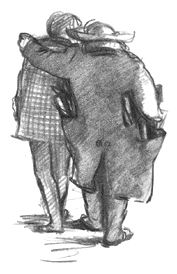Vie de Boheme – how the Bohemian Club was formed

Part 14 of 24
Schaunard found a seat in the ‘Grove’ – that is the name given at Mother Cadet’s to a shrubbery dotted with two or three rachitic trees, whose sickly greenery has been converted into a ceiling.
“Ah, well,” he said, “I’ll give myself a blow-out; I’ll be Belshazzar all on my own.” Without more ado he ordered soup, a half-portion of choucroute and two half-portions of rabbit. He had noticed that two half-portions were larger by at least a quarter that one full portion.
This order earned him the attention of a young person in a white dress, wearing orange blossoms in her hair and ballroom slippers. A veil of some kind of stuff, imitation of an imitation, was draped over shoulders that ought to have been more careful about their incognito. She was a singer from the Montparnasse Theatre, whose backstage regions practically open on to the kitchen of Mother Cadet’s. She had slipped out for a meal during an interval of Lucia di Lammermoor, and was ending with a small cup of coffee a dinner composed entirely of an artichoke dressed in oil and vinegar.
“Two portions of rabbit-stew, my goodness!” she murmured to the girl who was waiting on her. “There’s a young fellow who does himself well. How much do I owe you, Adèle?”
“Four the artichoke, four the coffee, one sou for the bread. That makes nine sous.”
“Here you are,” said the singer, and went out humming: “Love that God has given me …”
“She puts a lot into her la,” said a mysterious person who was sitting at Schaunard’s table, half hidden by a wall of books.
“Does she?” said Schaunard. “I would rather say that she takes all she can out of it. What an idea, anyway” – he pointed at the plate on which Lucia of Lammermoor had been eating her artichoke – “pickling her falsetto in vinegar!”
“It’s a strong acid,” said the other. “The variety produced by the town of Orleans enjoys a great reputation.”
Schaunard looked with interest at the eccentric who used such odd baits for conversation. The fixed stare of the latter’s large blue eyes, which seemed to be always seeking something, gave his physiognomy that characteristic air of blessed calm which is to be observed amongst scholars. His face was of the colour of old ivory, except for the cheeks, which had an overlayer of the colour of powdered brick. His mouth looked as if it had been drawn by an elementary art student whose elbow had been jogged. The lips, curving back a little in negro fashion, revealed a spaniel’s teeth. His chin was settled in two folds on a white tie, one end of which pointed to the stars and the other to the ground. Under a shiny felt hat with an enormous brim his hair escaped in blond cascades. He wore a nut-coloured greatcoat whose threadbare material was corrugated like a grater. From its gaping pockets protruded bundles of papers and brochures. Heedless of the scrutiny to which he was being subjected, he was enjoying a choucroute garnie, with undisguised sounds of satisfaction. As he ate, he read a book open before him, in which from time to time he made notes with a pencil taken from behind his ear.
[To be continued …]
[Vie de Bohème by Henry Mürger, a vivid portrait of the ‘Bohemian’ life of the artistic quarter of Paris in the nineteenth century was originally published (by Michel Lévy) in 1851. The extract above is taken from a translation by Norman Cameron, published by Hamish Hamilton. The illustration is by Dodi Masterman.]
Leave a Response
You must be logged in to post a comment.

